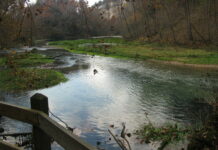Photo credit: DiasporaEngager (www.DiasporaEngager.com).
Discussion
Legionella bacteria are found naturally in freshwater environments, can survive under a wide range of environmental conditions, and typically grow best in warm water at temperatures of 77°F–113°F (25°C–45°C) (1). Exposure to water outside of human-made systems is not generally considered a risk factor for Legionnaires disease, which typically occurs after inhalation of water droplets containing Legionella (although aspiration is a recognized route of infection) (2). Before the cases described in this report were observed, infections with Legionella attributed to aspiration resulting from near-drowning incidents have been documented (3).
Legionnaires disease incidence has increased substantially during the past decade, reaching a peak of 2.71 cases per 100,000 persons in 2018 (4). Most cases are not associated with a known source, although approximately 18% have a reported health care facility–associated exposure (5). The Centers for Medicare & Medicaid Services requires that all acute care hospitals design and implement a water management program to reduce the growth and spread of Legionella.§ An effective water management program, along with strict adherence to infection control guidance, remain the best means to prevent health care–associated Legionnaires disease (6). Although solid organ transplantation is known to increase the risk for infection with Legionella, likely due to required immunosuppressive therapy, transmission via the organs themselves has not previously been reported (2). As with all infections in transplant recipients, prompt identification is critical to limit morbidity and mortality.
Despite a lack of confirmatory clinical or genomic evidence, three factors suggest that the transplanted lungs were the likely source of infection in the two cases presented in this report. First, different Legionella species were identified in the two patients. This can potentially be explained by infections derived from the donor’s exposure to river water, which might contain a larger diversity of Legionella species compared with potable water (7). Second, a review of records from the transplant facility indicated that water parameters were within expected ranges and the hospital did not report any disturbances to the building’s water system, recent changes in water quality parameters, or other events that might have increased the risk for infection with Legionella during this period. Finally, no other cases of legionellosis were reported from this facility within the 12-month period surrounding the two reported cases and no other possible sources of exposure were identified. Given the tight clustering in time, identification of additional cases would be expected if the source was the hospital facility’s water system or cooling towers.
Limitations
The findings in this report are subject to at least three limitations. First, clinical specimens were not available from the donor for testing for Legionella. As a result, the presence of infection with Legionella in the donor before organ donation could not be confirmed. Second, specimens from the patients were not available for additional laboratory analyses which might have better characterized the species and serotypes present. In addition, the heart and kidney transplant recipients did not receive any Legionella-specific testing. Finally, the transplant hospital’s building water system and cooling towers were not tested for Legionella before or immediately after the surgical procedures. Although the hospital’s water parameter data indicate a well-maintained system, presence of Legionella bacteria in the water system at the time of the transplants cannot be ruled out.
Implications for Public Health Practice
This report adds to the understanding of microbial risk assessment among recipients of organs from donors who died from drowning. Previous studies have documented bacterial and fungal pathogen transmission to transplant recipients when the donors have drowned, which have sometimes resulted in outcomes including bacterial and fatal fungal infections (8–10). The present findings suggest that clinicians caring for patients who receive organs from donors who experienced freshwater drowning also should maintain a higher index of suspicion for legionellosis, even in organ recipients without classic clinical symptoms. In such patients, posttransplant antimicrobials could be tailored to include agents that combat atypical waterborne organisms. When an unexpected donor-derived infection is suspected, providers are required to report the case to the United Network for Organ Sharing or OPTN for investigation by DTAC and to public health authorities for expedited evaluation and identification of potentially infected organs and tissues.¶ Prompt assessment by astute clinicians can result in more rapid diagnosis and treatment of Legionnaires disease, which requires organism-specific testing, thereby increasing the likelihood of a full recovery.
Source of original article: Centers for Disease Control and Prevention (CDC) / Morbidity and Mortality Weekly Report (MMWR) (tools.cdc.gov).
The content of this article does not necessarily reflect the views or opinion of Global Diaspora News (www.GlobalDiasporaNews.com).
To submit your press release: (https://www.GlobalDiasporaNews.com/pr).
To advertise on Global Diaspora News: (www.GlobalDiasporaNews.com/ads).
Sign up to Global Diaspora News newsletter (https://www.GlobalDiasporaNews.com/newsletter/) to start receiving updates and opportunities directly in your email inbox for free.





























